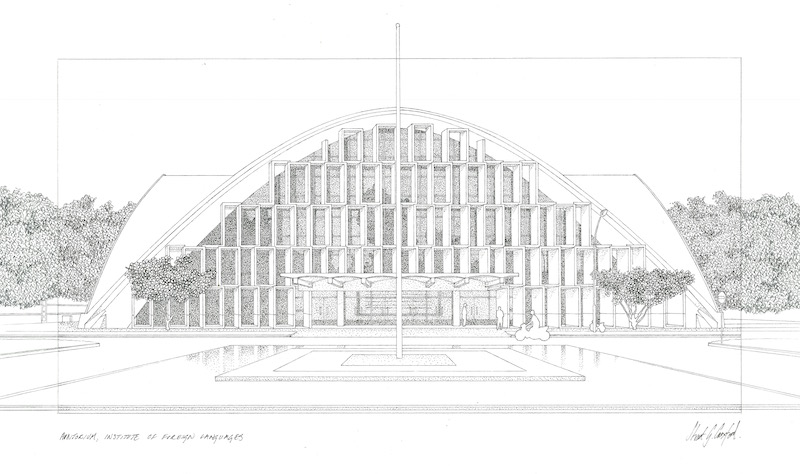Stuart Croxford is an artist. He’s also a qualified architect. Combining these two talents has enabled him to depict Phnom Penh’s buildings in a unique way, capturing the beauty with the eye of an artist and the precise lines with an architect’s mind.
He has put this skill to good use, producing 22 illustrations detailing some of the capital’s historic landmarks. The result is an exhibition, “Penh to Paper,” which goes on display on Wednesday in the city.

Among the buildings he turned his hand to are the Olympic Stadium and Central Market. He celebrates the work of architects such as Vann Molyvann, Jean Desbois and Mam Sophana, sweeping across the architectural landscape from the French colonial era to the angular post-independence “New Khmer” architecture.
The first building that Mr. Croxford sketched was actually an Angkorian monument, as he wanted to show architecture from different eras. He chose one near Phnom Penh, an 11th century temple, Phnom Chisor, built atop a hill in Takeo province. It would have dominated the region’s skyline at the time.
“I wanted to capture a building from the Angkorian period and the bathing pools seemed to fit the symmetrical theme” of the series, he said.
His selection of buildings—painstakingly detailed in black-and-white renderings by pen—gives away the fact that the artist is also an architect.
He includes, for instance, buildings whose intricate design may not be obvious at first glance, but which comes to light in his renderings.
As he explained in an email on Friday, “The National Library [built in the 1920s] employs very subtle decorative features in the form of reliefs, tiling and motifs, and the Unesco office building [from the 1910s]…once you see beyond the external paint, the detailing is quite significant.”
One of his favorites is the group of buildings at the Institute of Foreign Languages, on the Royal University of Phnom Penh campus.
Built in the 1960s, Mr. Croxford said, “it’s great to see the buildings functioning today as they were first intended to do so and the auditorium was the building I enjoyed drawing the most.”
Originally from Scotland, Mr. Croxford worked as an architect on historical building restoration in the U.K. and on contemporary buildings in China. While based in Shanghai, he became more involved in art and, after moving to Cambodia in 2015, became a full-time artist.
Every rendering involves a great deal of work. “I actually go to each building and take many photographs of the whole building and also details of elements such as windows, columns and doors,” Mr. Croxford said.
Back in his studio, “all the drawings are outlined in graphite first then gone over in pen so everything essentially is drawn twice. I then render the drawings using pen, which helps highlight the details and shadows.”
The works are done either on watercolor or acrylic painting paper.
Asked about the city’s architectural development over the last century, Mr. Croxford said that “[as] with many cities around the world, Phnom Penh’s architecture has evolved in response to the social, cultural and economic factors at the time the buildings were designed.”
The early French colonial buildings have various styles of European influence such as rococo and neoclassical, he said.
There were “a few nods to Cambodia’s past” in the early 1920s with George Groslier’s “traditional colonial” National Museum, which blended traditional Khmer with local Buddhist architecture, he said. In the 1930s, the use of cross-ventilation in Jean Desbois and Louis Chauchon’s art deco Central Market reflects local traditions.
“However, in the current era, although encouraged to do so, developers are not bound to incorporate traditional Khmer design or references and so it is slowly moving away from an architecture that identifies and makes this city great,” he said.
Attempts made around the world have demonstrated that historical building preservation can co-exist with development, Mr. Croxford said.
In Phnom Penh, he added, “the historic buildings are fantastic and contribute to the reason why [the city] is a nice environment to be in. It’s important to retain these to exist and function alongside the inevitable new developments.”
Exhibition
What: “Penh to Paper”
Where: Plantation Urban Resort & Spa, Lotus Pond Gallery, #28 Steet 18, Phnom Penh
When: Opens Wednesay, 6:30 p.m. Ends August 1
Free admission